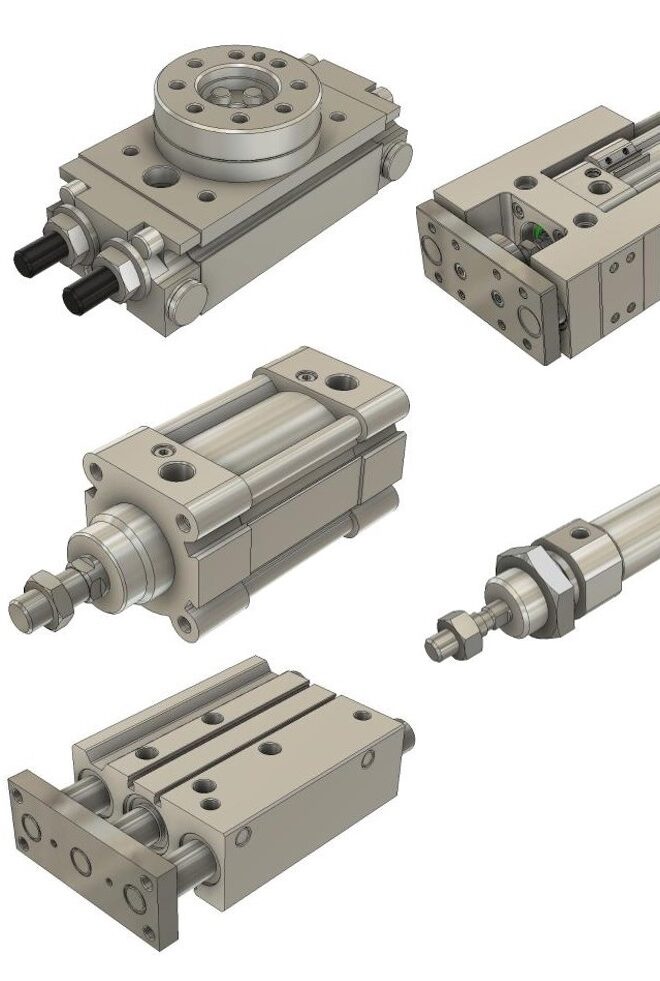
What is a pneumatic actuator?
A pneumatic actuator is a device that converts the energy of compressed air into mechanical motion. It is one of the essential components in industrial automation systems, used to perform a variety of operations such as lifting, moving, rotating, and clamping.
Construction of a pneumatic actuator
A pneumatic actuator consists of several key components:
- Cylinder – the main housing of the actuator in which the piston moves. A cylinder is typically made of metal, such as steel or aluminum.
- Piston – an element inside the cylinder that moves under the influence of compressed air. The piston is equipped with seals that prevent air leakage.
- Piston rod – a rod attached to the piston that transmits the movement of the piston to the outside of the cylinder.
- End Covers – Enclose the cylinder at both ends and may include holes for connecting air lines.
- Seals – elements to protect against air leakage and increase the durability of the actuator.
- Springs – some cylinders use springs to help the piston return to its original position.
Types of pneumatic actuators
Pneumatic actuators can be divided into several types, depending on their design and mode of operation:
- Single-acting cylinders – the piston in such an actuator moves in one direction under the influence of compressed air, and the return to the original position is made by a spring or weight.
- Double-acting cylinders – the piston moves in both directions under the influence of compressed air, which allows for precise control of the movement in both directions.
- Rodless cylinders – in these cylinders, the piston moves inside the cylinder without a protruding piston rod, which saves space. These actuators are often used in applications where space is limited.
- Rotary actuators – instead of linear motion, they produce rotary motion. They are used in applications that require precise rotation of components.
ISO Standard Reference
In our machines, we use standard solutions based on components standardized by ISO and easily available to reduce the customer’s spare parts warehouse. With the use of standard components, the time of possible failure is reduced to a minimum, without the need for our customers to have an extensive warehouse of spare parts.
Pneumatic actuators are regulated by ISO standards, which ensure their quality and compatibility with other components of pneumatic systems. The most important standards are:
ISO 6431 – specifies dimensions and requirements for double-acting pneumatic cylinders with diameters from 32 mm to 320 mm.
ISO 15552 – replaces ISO 6431 and introduces more detailed requirements for cylinder design and performance.
ISO 21287 – applies to compact pneumatic cylinders with diameters from 20 mm to 100 mm.
These standards help to ensure that actuators are manufactured to specific standards, allowing them to be used seamlessly in a variety of industrial applications.
Guided cylinders
Among the different types of pneumatic actuators, there are also guided actuators. They are used in applications where the mechanical system requires the transmission of forces causing the bending of the piston rod.
In the case of this type of actuators, it is difficult to talk about normalization of dimensions. Each manufacturer makes them according to its own key. They differ in mounts, which makes it impossible to replace them with another counterpart. They also differ in the type of guidance and the forces that can be predicted by a given actuator.
These actuators are a simplified version of the module, which uses a standard actuator and an additional linear guided system. This system can be specially designed or ready-made. Linear guidance provides additional stability and precision, preventing piston rod bending and minimizing the risk of damage.
These types of solutions are particularly useful in applications that require high accuracy and durability, such as manipulators, assembly systems or production machines. By using linear guides, guided actuators can accommodate higher side loads and bending moments, which significantly expands their range.
Actuator selection and settings
Pneumatic damping in cylinders
It is worth noting that many pneumatic cylinders are equipped with pneumatic damping, such as an air bag or air bumper. These elements are designed to cushion the movement of the piston at the end of its stroke, which is especially important in the case of fast movements made by the cylinder.
The airbag works by gradually increasing the air resistance in the cylinder, which slows down the movement of the piston before reaching its final position. The air bumper is another type of damping that also uses air for cushioning, but it works slightly differently to absorb the piston’s kinetic energy.
It should be remembered that not all actuators are equipped with such solutions. In the absence of pneumatic damping or incorrect setting of the final compression, a characteristic metallic impact sound is often heard. When the actuator operates for a longer period of time, it wears out quickly and the end covers are knocked out, which leads to the need for earlier replacement or repair of the actuator.
Regeneration and appropriate selection of pneumatic cylinders
Screwed pneumatic cylinders, unlike welded ones, can be regenerated by replacing the seals in the event of a leak due to wear. This makes it possible to extend the life of the cylinder without having to replace it completely.
Appropriate selection of seals
It is important to choose the type of cylinder with seals adapted to the operating conditions of the device. Depending on the environment in which the actuator will operate, seals that can withstand high temperatures, chemicals, or other specific factors may be required.
Piston rod covers
In the case of work in dusty conditions, it is necessary to use piston rod covers. These guards prevent dust from getting between the piston and the seal, which could lead to accelerated wear and cylinder failure. Taking care of proper protection of the piston rod is crucial to ensure long-term and trouble-free operation of the cylinder.
Monitoring of the position of the piston rod in pneumatic cylinders
It is also worth noting that pneumatic cylinders are not always equipped with the ability to detect the exact position of the piston rod. Essentially, the actuator operates in zero-one mode, moving the piston between extreme positions that are mechanically limited.
Piston position monitoring
The position of the piston can be monitored using limit sensors, usually Hall sensors, which detect the presence of a magnetic part placed on the piston rod. These sensors are mounted on the outside of the cylinder cylinder and respond to a magnet placed on the piston rod, signaling the piston to reach one of the two extreme positions with an accuracy of 2mm. It should be remembered that incorrect positioning of the airbag in the chamber may cause irregularities in the position of the cylinder piston.
Conclusion
Pneumatic actuators are versatile devices that are used in many areas of industry. From simple single-acting cylinders, to more complex double-acting, rodless, rotary, guided cylinders, to those equipped with pneumatic damping, each type has its own unique advantages and applications.
Thanks to the regulations of ISO standards, we can be sure of their quality and reliability in various industrial applications, which is crucial for maintaining efficiency and precision in production processes. Proper selection and maintenance of actuators, including adequate damping and protection against dust, is essential for their long-term and trouble-free operation. Reconditioning of bolted cylinders by replacing seals and monitoring the piston position with limit sensors are additional advantages that increase the functionality and durability of these devices.
Należy również pamiętać o aspektach bezpieczeństwa, takich jak zabezpieczenie przed nagłym zanikiem ciśnienia czy zatrzymaniem maszyny na noc, aby uniknąć sytuacji, w której siłowniki opadną i spowodują kolizje przy ponownym uruchomieniu. Dzięki odpowiedniemu zaprojektowaniu układu pneumatycznego można zapewnić nie tylko zgodność z normami, ale także bezpieczne i bezawaryjne działanie maszyny, co jest kluczowe dla ochrony pracowników i optymalizacji procesów produkcyjnych.






